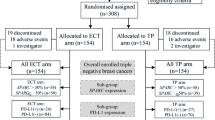Abstract
Reducing primary tumor volume is the main role of neoadjuvant chemotherapy for breast cancer. We evaluated the benefit of adding docetaxel to anthracyclin as neoadjuvant therapy. This study is a retrospective cohort analysis comparing the efficacy of neoadjuvant chemotherapy in patients subjected to docetaxel and epirubicin or 5-fluoruracil, epirubicin and cyclophosphamide combinations (DE and FEC group, respectively). The mean number of chemotherapy delivered was similar in both groups (P = 0.8). A total of 316 patients were treated (151 in FEC group and 165 in DE group). Primary endpoint was the clinical and pathological response to therapy. Breast conserving surgery rate was compared. In T1/2 staged patients, the complete clinical response rate was 7.5% in FEC group and 32% in DE group (P = 0.002), and the breast conserving surgery rate was 72 and 73% in FEC and DE groups, respectively (P = 0.9). In the subset of patients staged as T3 and T4a-c, objective response was higher in DE group (P < 0.0001 and P = 0.008, respectively). Breast conserving surgery rate was 38 and 63% in FEC and DE groups, respectively, in T3 staged patients and, 20.5 and 37% in T4a-c staged patients (P = 0.003 and 0.08). Despite the similar number of chemotherapy cycles delivered in both groups, the presence of microscopic axillary lymph node involvement after chemotherapy was less frequent in DE group. Neoadjuvant chemotherapy with DE combination is more effective in terms of clinical and pathological response propitiating higher breast conserving surgery rate than FEC combination in stage II and III breast cancer.
Similar content being viewed by others
References
Bear HD, Anderson S, Smith RE, Geyer CE Jr, Mamounas EP, Fisher B, et al. Sequential preoperative or postoperative docetaxel added to preoperative doxorubicin plus cyclophosphamide for operable breast cancer: National Surgical Adjuvant Breast and Bowel Project Protocol B-27. J Clin Oncol. 2006;24(13):2019–27.
Steger GG, Galid A, Gnant M, Mlineritsch B, Lang A, Tausch C, et al. Pathologic complete response with six compared with three cycles of neoadjuvant epirubicin plus docetaxel and granulocyte colony-stimulating factor in operable breast cancer: results of ABCSG-14. J Clin Oncol. 2007;25(15):2012–8.
Rastogi P, Anderson SJ, Bear HD, Geyer CE, Kahlenberg MS, Robidoux A, et al. Preoperative chemotherapy: updates of National Surgical Adjuvant Breast and Bowel Project Protocols B-18 and B-27. J Clin Oncol. 2008;26(5):778–85.
Fisher B, Brown A, Mamounas E, Wieand S, Robidoux A, Margolese RG, et al. Effect of preoperative chemotherapy on local-regional disease in women with operable breast cancer: findings from National Surgical Adjuvant Breast and Bowel Project B-18. J Clin Oncol. 1997;15(7):2483–93.
Agarwal G, Ramakant P, Forgach ER, Rendon JC, Chaparro JM, Basurto CS, et al. Breast cancer care in developing countries. World J Surg. 2009;33(10):2069–76.
Jakesz R. Breast cancer in developing countries: challenges for multidisciplinary care. Breast Care (Basel). 2008;3(1):4–5.
Whitman GJ, Strom EA. Workup and staging of locally advanced breast cancer. Semin Radiat Oncol. 2009;19(4):211–21.
Tabchy A, Valero V, Vidaurre T, Lluch A, Gomez HL, Martin M, et al. Evaluation of a 30-gene paclitaxel, fluorouracil, doxorubicin and cyclophosphamide chemotherapy response predictor in a multicenter randomized trial in breast cancer. Clin Cancer Res. Sep 9.
Darb-Esfahani S, Loibl S, Muller BM, Roller M, Denkert C, Komor M, et al. Identification of biology-based breast cancer types with distinct predictive and prognostic features: role of steroid hormone and HER2 receptor expression in patients treated with neoadjuvant anthracycline/taxane-based chemotherapy. Breast Cancer Res. 2009;11(5):R69.
Straver ME, Rutgers EJ, Rodenhuis S, Linn SC, Loo CE, Wesseling J, et al. The relevance of breast cancer subtypes in the outcome of neoadjuvant chemotherapy. Ann Surg Oncol. Sep;17(9):2411-8.
Untch M, Rezai M, Loibl S, Fasching PA, Huober J, Tesch H, et al. Neoadjuvant treatment with trastuzumab in HER2-positive breast cancer: results from the GeparQuattro study. J Clin Oncol. Apr 20;28(12):2024-31.
Chen AM, Meric-Bernstam F, Hunt KK, Thames HD, Oswald MJ, Outlaw ED, et al. Breast conservation after neoadjuvant chemotherapy: the MD Anderson cancer center experience. J Clin Oncol. 2004;22(12):2303–12.
Beriwal S, Schwartz GF, Komarnicky L, Garcia-Young JA. Breast-conserving therapy after neoadjuvant chemotherapy: long-term results. Breast J. 2006;12(2):159–64.
Tiezzi DG, Andrade JM, Marana HR, Zola FE, Peria FM. Breast conserving surgery after neoadjuvant therapy for large primary breast cancer. Eur J Surg Oncol. 2008;34(8):863–7.
Fitzal F, Riedl O, Mittlbock M, Dubsky P, Bartsch R, Steger G, et al. Oncologic safety of breast conserving surgery after tumour downsizing by neoadjuvant therapy: a retrospective single centre cohort study. Breast cancer research and treatment. Sep 17.
Cox CE, Cox JM, White LB, Stowell NG, Clark JD, Allred N, et al. Sentinel node biopsy before neoadjuvant chemotherapy for determining axillary status and treatment prognosis in locally advanced breast cancer. Ann Surg Oncol. 2006;13(4):483–90.
Kuerer HM, Sahin AA, Hunt KK, Newman LA, Breslin TM, Ames FC, et al. Incidence and impact of documented eradication of breast cancer axillary lymph node metastases before surgery in patients treated with neoadjuvant chemotherapy. Ann Surg. 1999;230(1):72–8.
Schrenk P, Hochreiner G, Fridrik M, Wayand W. Sentinel node biopsy performed before preoperative chemotherapy for axillary lymph node staging in breast cancer. Breast J. 2003;9(4):282–7.
van Rijk MC, Nieweg OE, Rutgers EJ, Oldenburg HS, Olmos RV, Hoefnagel CA, et al. Sentinel node biopsy before neoadjuvant chemotherapy spares breast cancer patients axillary lymph node dissection. Ann Surg Oncol. 2006;13(4):475–9.
Hennessy BT, Hortobagyi GN, Rouzier R, Kuerer H, Sneige N, Buzdar AU, et al. Outcome after pathologic complete eradication of cytologically proven breast cancer axillary node metastases following primary chemotherapy. J Clin Oncol. 2005;23(36):9304–11.
Conflict of interest
All the authors have no conflict of interest.
Author information
Authors and Affiliations
Corresponding author
Rights and permissions
About this article
Cite this article
Andrade, J.M., Carrara, H.H.A., Pimentel, F.F. et al. Taxane-based chemotherapy enhances response to neoadjuvant treatment for stage II and III breast cancer. Med Oncol 28 (Suppl 1), 65–69 (2011). https://doi.org/10.1007/s12032-010-9711-0
Received:
Accepted:
Published:
Issue Date:
DOI: https://doi.org/10.1007/s12032-010-9711-0




